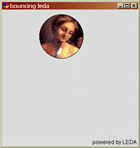BufferingThere are situations where it is not desired that drawing operations immediately draw into the drawing area of a window and where it is useful to construct the entire drawing in a memory buffer before copying it (or parts of it) into the drawing area of the window. On the right there is a screenshot of the example program "Bouncing LEDA". |
 |
Applications
- Animations where one wants to display a sequence of snapshots of a scene that changes over time
- Creation of a pixrect copy of a drawing without displaying it
Operations
The following operation starts the buffering. All subsequent drawing operations have no effect in the drawing area of the displayed window, but draw into an internal buffer with the same size and coordinates as the drawing area ofW.
void W.start_buffering();The operations
void W.flush_buffer(); void W.flush_buffer(double x0, double y0, double x1, double y1)copy the contents of the complete internal buffer, respectively the contents of the rectangle (x0,y0,x1,y1) of the buffer, into
W. The second
variant is much faster if the rectangle is significantly smaller than the
drawing area of W. The operation
void W.stop_buffering(char* & pr);stops the buffering and converts the internal buffer into
pixrect
pr.